At the end of the month-long fast of Ramadan comes a three-day holiday called Eid al-Fitr, which means “The Festival of Fast-Breaking”. People greet each other by saying Eid Mubarak (“Blessed Festival”), and during this time charity is given to needy families, gifts are given to children, and people get dressed up and visit family and friends. As you can imagine, food of every kind (but especially sweets) is abundant.
Bakdash Ice Cream Parlor, Souk Al Hamidiya, Damascus, Syria (Image Source)
The first time I enjoyed Syrian ice cream (which is called Éma’a) was where it originated - at Bakdash Ice Cream parlor in the Souk Al Hamidiyah in Damascus. It is so much fun to head to Bakdash and watch this being made. It's pounded with large wooden mallets and then pulled and stretched, owing its taffy-like consistency to an ingredient called mastic gum.
I recently had a craving for this ice cream, and because Mike and I aren’t planning a trip back to Syria for a while, I knew I would have to come up with a recipe myself. And what better time to make it than for the Eid?
My very sweet mother-in-law told me the main ingredients in Éma’a, which are fairly well-known: milk, mastic gum, sugar, sahlab, and rose water (plus of course the pistachio coating!). There are two ingredients that are somewhat uncommon – mastic gum and sahlab – but both are available in Middle Eastern grocery stores or on Amazon.
Mastic gum is a really interesting ingredient. It comes in little yellow crystals (the medium-sized pieces are about ½ cm wide by 1 cm tall) called tears, and has the look and feel of beach glass. It has a strong perfume-y smell, and I actually think it smells just like Tide laundry detergent. Here is what it says about mastic on the back of the package: “[Mastic is] a unique product with many beneficial qualities and wide-ranging uses since antiquity. Nowadays, it is used in pharmaceuticals, perfumes, cosmetics, beverages, baking goods, sweets, as well as in cooking. Mastiha is the natural resin of pistacia lentiscus variety Chia, a tree which grows only on the Aegean island of Chios, Greece. Scientific research shows that Chios Mastiha has anti-microbial, anti-inflammatory and healing activity. It contributes to a healthy gastrointestional system and has beneficial effects for both oral hygiene and skin care.”
Sahlab is a mixture of cornstarch, sugar, and sahlab (roots of orchids mascula). If you can’t find sahlab, you can substitute an equal part of cornstarch plus a couple drops of orange blossom water.
After we bought these ingredients, the hardest part was figuring out the proportions of each. After some trial and error I came up with a recipe that Mike and I both feel is a pretty close replication of the original. I use 9 parts whole milk and 1 part heavy cream, but feel free to use all whole milk if you prefer.
Eid Mubarak to all celebrating!
- 9 cups plus ¼ cup whole milk, divided
- 1 cup heavy cream
- 4 medium pieces (about ¼ teaspoon) mastic gum (also called Arabic gum)
- 2½ cups sugar
- 5 teaspoons sahlab
- ¾ teaspoon rose water
- Chopped pistachios, for serving
- In a small bowl, whisk together ¼ cup milk with the sahlab; set aside.
- Grind the mastic into a powder; the best way to do this is to put the mastic between 2 pieces of parchment paper or inside a plastic bag and pound it with a heavy object, such as a rolling pin.
- Add the remaining 9 cups of milk, the cream, and the mastic to a large pot over medium heat; bring to a boil, stirring frequently.
- Once boiling, slowly whisk in the sugar and bring back up to a boil, stirring constantly. Whisk in the sahlab mixture and boil vigorously 5 minutes, then turn off the heat and add the rose water.
- Cool to room temperature, then refrigerate until well chilled, about 4 to 6 hours.
- Transfer the chilled mixture to an ice cream machine and process according to the manufacturer’s directions.
- Once processed, put the ice cream in a freezer-safe bowl and transfer to the freezer to set.
- Serve topped with chopped pistachios.
Here are a few photos of Bakdash we took while we were in Damascus in 2011...

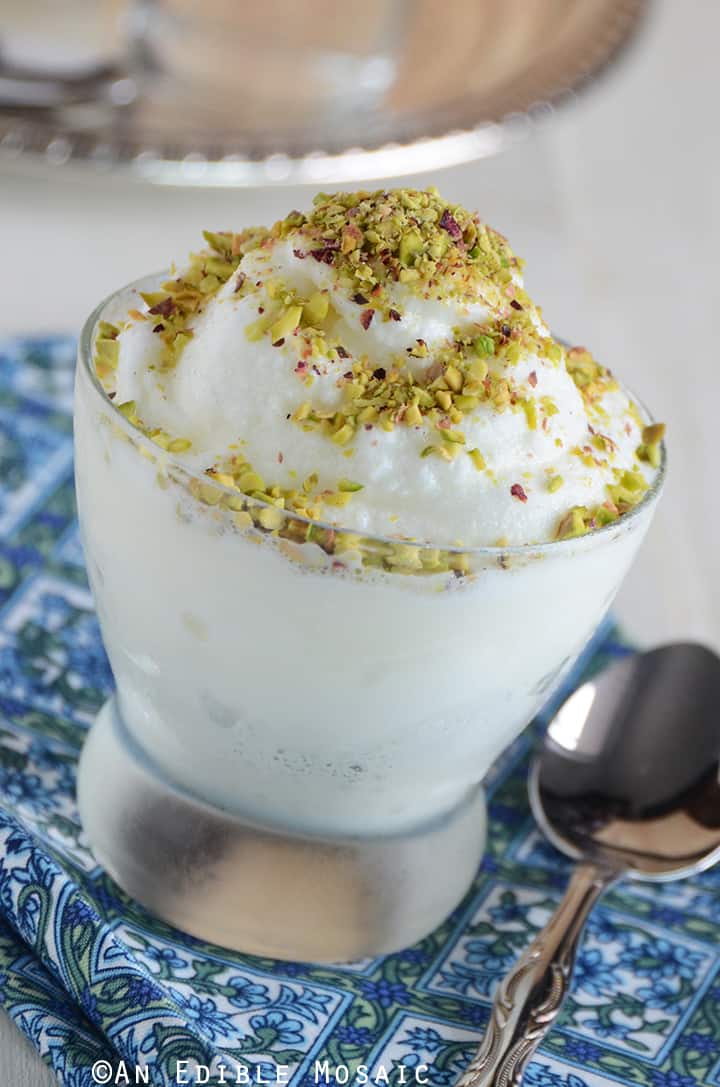
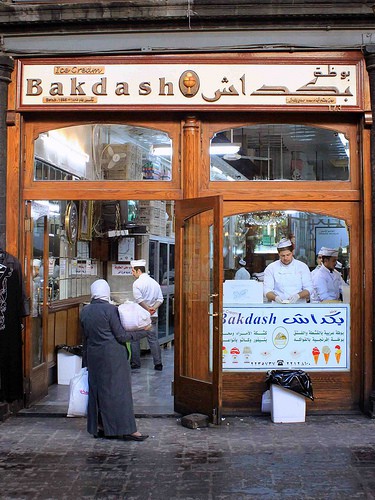
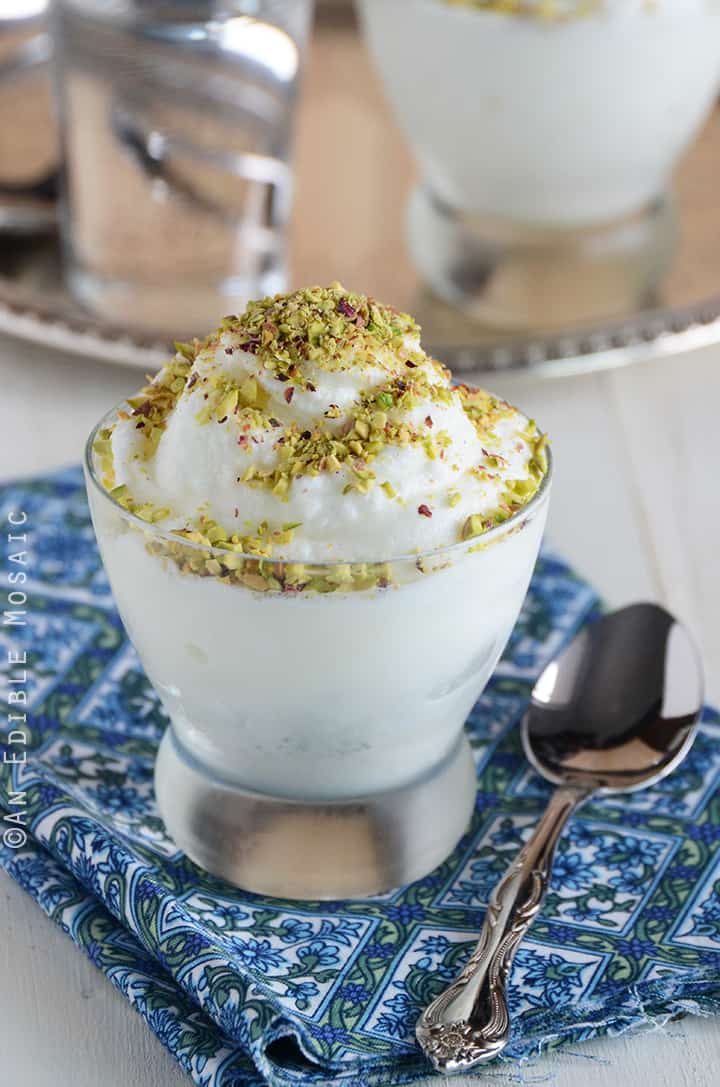
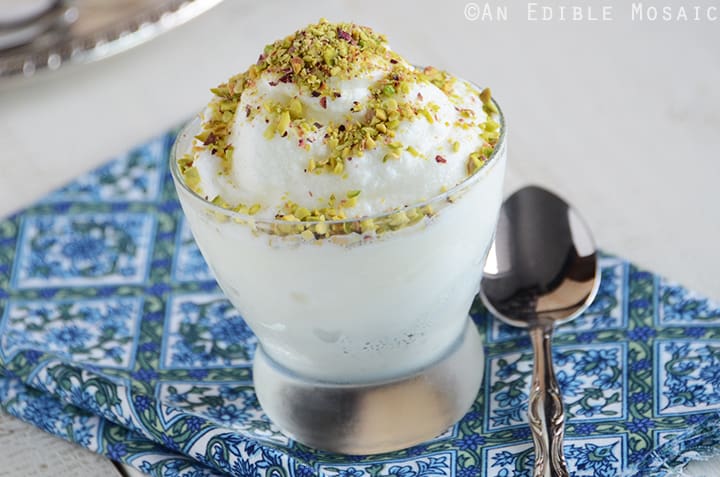
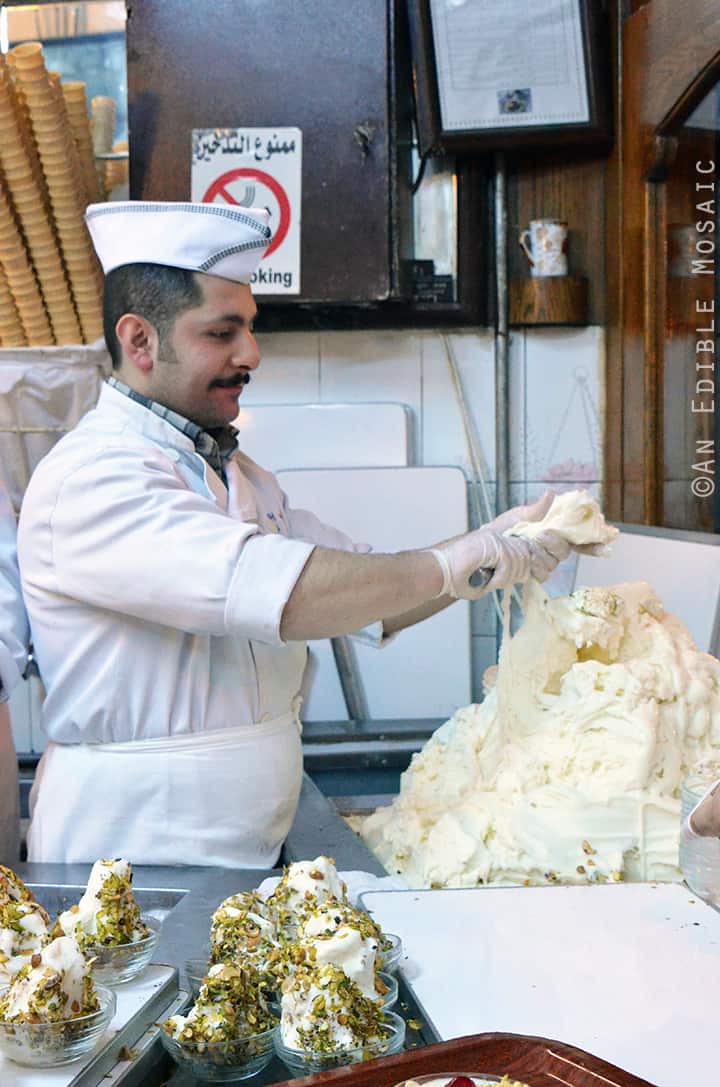
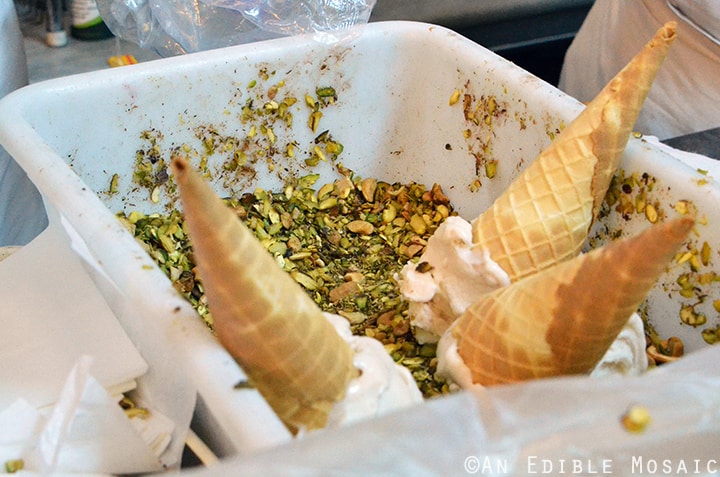
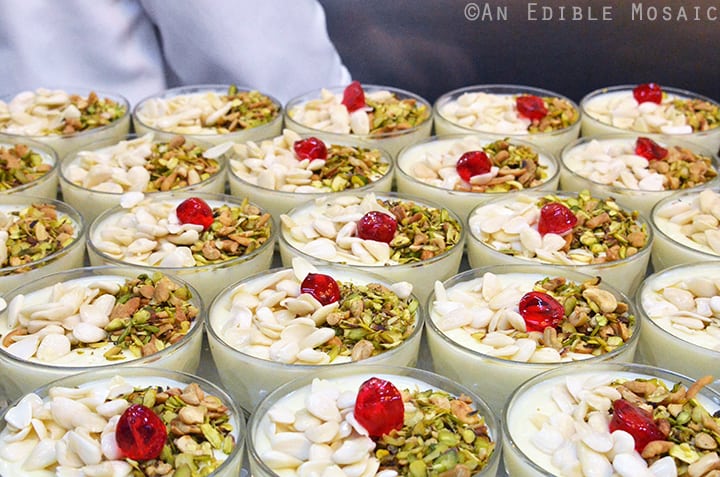
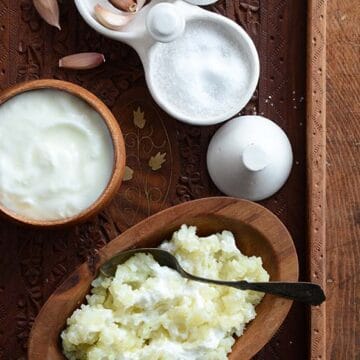
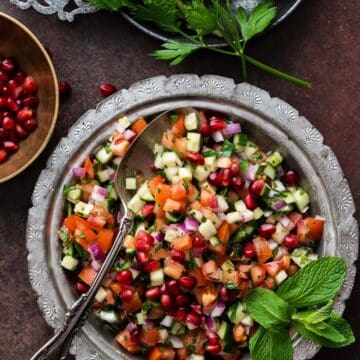
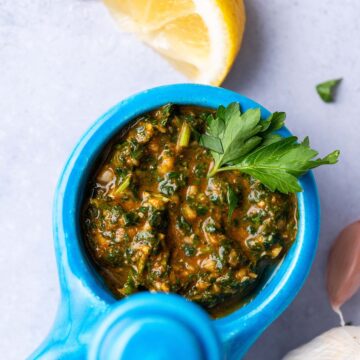
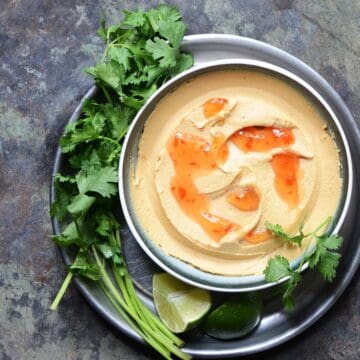
Ahmad a says
I LOVED reading this article. It made me miss back home so much. I'm from Syria but a Chicago transplant. Mastic gum (tears of Chios) is an important ingredient in Syrian desserts. I wish you tried Halawet el jibin (cheese pastry).
Cheers!
Colette says
Hey, also went to that same place in Damascus. Love that ice-cream and lucky enough to still be able to get it here in Qatar. However I have to point out that mastic gum and arabic gum are not the same thing. Mastic is from the sap of the mastic tree while arabic gum is from the acacia tree. Mastic is also expensive because it is so rare. Going to try and make the ice-cream soon since I finally got my hands on some mastic gum!
Tara says
Love this! I tried another recipe that used double the amount of mastic gum- way too much. Found yours and it was perfect! Love the hint of rose water with the pistachio topping. Heat resistant so slightly easier for photographing too!
اية نصار says
انا اية انا كتير معجبة بشغلك مرت خالو و انشالله مندوق الاكل
Veronica says
This is so crazy! I was just visiting Dessert Stalking and when I saw the pic of this icec ream, I immediately thought of you and how it seemed like something you might make. And when I clicked it, what do you know? LOL, guess I've gotten to know you through your blog a little bit! This looks soooo good and I'm really intrigued by the chios gum mastic.
ingrid says
Very interesting.....While, I don't know if I'd try making it myself I would like to find somewhere that sells it.
~ingrid
Melanie says
Lovely--mastic is great for stomach ailments. I have eaten it in jellied candies, gum and in the little tear like natural state. Thanks for the lovely recipe.
Carolyn Jung says
An ingredient that smells like Tide that you use in dessert? Now, THAT is really worth trying. ;)
Marisa says
I'm going to need to track down mastic gum, because this is one thing I definitely have to make for summer!
FOODESSA says
Faith...as incredibly foreign as this is to me...you certainly sound like you know exactly what you're talking about. This ice-cream looks scrumptious...especially since it's enhanced by pistachios ;o)
Flavourful wishes,
Claudia
grace says
mastic, sahlab, rose water--these are ingredients that've never graced my kitchen. that said, what you've made, described, and depicted seems completely and utterly amazing--thanks so much for sharing!
tasteofbeirut says
This ice-cream place sounds wonderful; of course Damascus is renowned for its sweets! I love this ice-cream and took the trouble while in Istambul to hunt for sahlab which I found; come to find out it is available at some stores in Beirut as well, but not in the US; so one has to make do with the mix.
Chaya says
Thank you for introducing us to new foods and new flavors.
chriesi says
Oh this is an amazing dessert! Love it!
Joanne says
This sounds like a lovely celebration...I love the spirit behind Eid. And I'm thoroughly enamored with this ice cream! I've heard of mastic before but have not yet been able to find it. My local Middle Eastern market and I obviously have a date with destiny.
Jen says
Your ice cream looks seriously delicious with all of those pistachios on top!
Betty @ scrambled hen fruit says
This looks great, especially with the pistachio topping!
coco says
mouth watering here!!!! I so want to go and eat with you someday... you're such a foodie and so adventurous!!! :D
sara says
Wow, that ice cream looks fantastic! Love the pistachios. :)
theUngourmet says
That chios gum is wild! I love the photo of the Syrian ice cream parlor. Beautiful! Your ice cream is beautiful as well. I love the presentation with the pistachios on top!
Ameena says
Eid Mubarak Faith! I hope you are enjoying the weekend long celebration. I am just excited to be able to resume normal life. And I ate way too much yesterday!
This reminds me a bit of kulfi, which my parents absolutely love. Wonderful recipe.
Priyanka says
The nuts on top are driving me crazy to have a scoop of it :)
Eid Mubarak!
Von says
This is so cool! And it sounds delicious too! It just makes me want to go out buy all these interesting ingredients...
Barbara says
What an interesting post, Faith! This ice cream looks delicious. I really loved learning about these new (to me) ingredients. And the photo is making me hungry!
Loved the photo of Chios gum mastic....but Tide detergent??
MaryMoh says
Looks delicious with all the pistachio topping. Looks challenging to me to try and make. I'll have to feast with my eyes first :)
sophia says
STOP STOP STOP!!! You're making me very hungry again, and I just had dinner! >__<
Jen Cheung says
this looks really interesting :) love to try it out.
have a lovely weekend :)
jen @ http://www.charmoflife.ca
BeadedTail says
I hadn't heard of this ice cream before but it sounds wonderful! I'm so impressed that you were able to recreate it. You are very talented!
Aimee says
This looks great and I loved reading more about the unique ingredients. I kind of thought it might taste a bit like Kulfi, which is Indian pistachio ice cream, but I've never tried the two ingredients that you described so I can't really be sure. I loved the photos too.
Reeni says
Thank you for introducing me to this ice cream and these exotic ingredients. I am so impressed with your recipe recreations. The ice cream looks so delicious with all those pistachios crusting the top! Eid Mubarak!
Lorraine @ Not Quite Nigella says
Thankyou so much for sharing this recipe Faith! I've never seen mastic as a raw ingredient, only in foods so it's great to see what it looks like. I am going to have a hunt for this! Eid Mubarak! :D
Julie says
very interesting and looks delicious!
Cara says
Very, very impressive!
Your creations always impress me. You are so talented.
Louise Mellor says
I'm am so intrigued with culture and religion and how it plays into every thread of our lives. thanks for sharing- rose water, been meaning to try that out in an ice cream or custard.
~Chef Louise
The Southern Cookbook says
This looks awesome. I would love to make this, I think I would have a hard time finding the Chios gum mastic tears. Pistachios and ice cream go sooooo good together.
Lentil Breakdown says
Wow, that is really interesting! Is sahlab what they use in Turkish Delight candy? I know the base is made from cornstarch and sugar, but not sure about the orchids.
Monet says
I have never seen anything like this...it looks so tasty though...I wish I had a bowl in front of me now. Thank you for sharing something so different from my day-to-day experiences.
Diane says
This sounds delicious but I doubt if I will ever find the ingredients in France :-( Diane
Jessie says
What a beautiful ice cream! I can see why you wanted to recreate this. I'd love to attempt a version of this (good use for the rosewater I have lying around), although I might have trouble sahlab and mastic! I might have to live vicariously through you, Faith :)
Have a great weekend!
Maria @ Scandifoodie says
Wow this looks really delicious! I love the pistachios on top!
Biren @ Roti n Rice says
The ice cream looks delicious and the chios gum mastic is an interesting ingredient.
Blond Duck says
Can I skip the fasting and go straight to the ice cream?
Sophie says
I also haven't seen a lusciously looking ice cream like this! Thanks, Faith for introducing it to us!
MMMMMMMMMMMMM,...!! Lovely pictures too!
Louanne says
Oh wow, this looks amazing, Faith! I have to find all of these ingredients so I can make this!
marla {family fresh cooking} says
I have never seen an ice cream like this. Thanks for sharing your culinary wisdom with us. Faith, not only do I love your blog for the gorgeous photos & recipes, but for the cultural lessons I learn too! The gum mastic sounds amazing in it's health properties and flavor. Have a wonderful weekend! xo
Dana says
You must have so much patience to try and recreate something like this! Looks delicious.. I love pistachios on my ice cream :)
Honey @ honeyandsoy says
Eid Mubarak! So many of the ingredients in this ice=cream are new to me, so it's been really interesting reading about them. The gum mastic tears remind me of rock sugar. Lovely looking ice-cream!
5 Star Foodie says
This ice cream sounds incredible! I learned about Chios gum mastic in Greece where I also try the mastic liqueur and the mastic liqueur flavored ice cream. I am definitely intrigued by this ingredient and hope to find it here.
Astra Libris says
Thank you for introducing me to this incredible ice cream! Wow!
I'm so sorry I've been away for a while (more health issues, sigh) - I'm so happy to be back, reading and catching up on one of my favorite blogs - yours! :-)
Katerina says
I love the taste of mastic in sweets. We also have many sweets with mastic here in Greece. I am sure I would love this ice cream too.
deana@lostpastremembered says
It seems we both have ice cream on the brain this week! I was reading about persian ice cream with Vermicelli, rosewater, saffron and pistachios... looks like this is a cousin... you really make me want to try this!! I have mastic that has no scent (in fact the package trumpets that) I want the kind you used now~~
Rosa says
A splendid ice cream! Eid Mubarak Said to all our Muslim friends!
Cheers,
Rosa
Sanjeeta kk says
Lovely and creamy ice cream!!
Sara says
Faith, my mouth is watering looking at your pics of this Syrian Ice Cream!!!
Eid Mubarak!!! :}
Anh says
eid mubarak! :)
And hey, you should invite me over with this dessert! I am dying to taste it!!!
Heavenly Housewife says
Eid Mubarak!
Beautiful ice cream, so exotic and lovely, fit for a princess :)
*kisses* HH
Anna Johnston says
Wow Faith, this looks amazing. I really enjoyed reading the history & various ways Chios Gum Mastic are used, I find these things so interesting & adore some of the arabic sweets, I always knew there were difficult to source ingredients used..., but didn't even know the name of them. This one looks so good, don't think I've ever come across it before either, so thanks so much for sharing :)
Emily Z says
Hmmm, I suppose it might be worth fasting if you get a festival to break it at the end. Especially if you get to eat something like this. It looks delicious! Love all the pistachios!